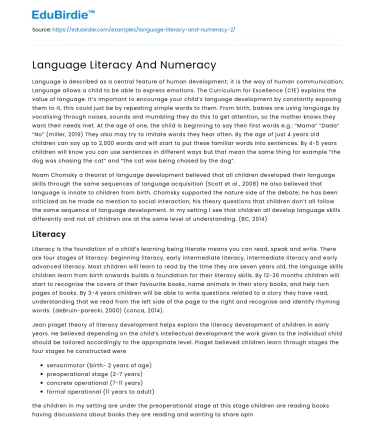Introduction
Language literacy and numeracy are foundational elements critical to personal and societal development. These skills not only empower individuals to engage effectively in daily tasks but also facilitate participation in the global knowledge economy. Language literacy involves the ability to read, write, and communicate effectively, while numeracy refers to the capability to use mathematical concepts in practical contexts. Together, they form the bedrock of education, underpinning the ability to learn and adapt to various life challenges. As the world becomes increasingly interconnected, the demand for these skills continues to grow, emphasizing the need to prioritize their development across educational systems. The importance of language literacy and numeracy extends beyond individual proficiency; it is integral to economic growth, social inclusion, and active citizenship. This essay explores the significance of language literacy and numeracy, examines strategies for their enhancement, and addresses potential challenges in fostering these skills.
The Significance of Language Literacy and Numeracy
The role of language literacy and numeracy in modern society is multifaceted and profound. At the individual level, these skills are essential for personal empowerment and independence. According to UNESCO (2016), literacy is a driver for sustainable development, enabling individuals to improve their livelihoods and participate fully in society. Language literacy enables individuals to access information, express ideas, and engage in social dialogue. For instance, a literate person can understand public health information, making informed decisions that affect their well-being. Similarly, numeracy skills are crucial for managing personal finances, understanding economic trends, and participating in informed decision-making processes. As such, these skills are pivotal in enhancing the quality of life and promoting equity within communities.
Save your time!
We can take care of your essay
- Proper editing and formatting
- Free revision, title page, and bibliography
- Flexible prices and money-back guarantee
Beyond the individual, language literacy and numeracy contribute significantly to societal and economic progress. Nations with higher literacy and numeracy rates often experience more robust economic growth and greater social cohesion. The OECD (2013) highlights that proficiency in these skills correlates with increased employment opportunities and higher earnings. Moreover, a literate and numerate population is better equipped to innovate and compete in a globalized economy. The ability to process complex information and solve problems is critical in various sectors, from technology to healthcare. Thus, investing in language literacy and numeracy is not only a matter of personal development but a strategic imperative for national prosperity.
Strategies for Enhancing Literacy and Numeracy Skills
Enhancing language literacy and numeracy requires comprehensive strategies that address diverse learning needs and contexts. One effective approach is integrating literacy and numeracy across the curriculum. This integration ensures that students encounter these skills in various subjects, reinforcing their applicability and relevance. For example, incorporating mathematical concepts in science classes or using literature to explore historical events can deepen understanding and retention. Moreover, technology plays a pivotal role in enhancing these skills. Digital tools and resources can provide interactive and personalized learning experiences, catering to different learning styles and paces. Platforms like Khan Academy and Duolingo leverage technology to support learning, offering users the flexibility to practice skills at their convenience.
Furthermore, community involvement is crucial in fostering language literacy and numeracy. Programs that engage parents, local organizations, and businesses can create a supportive learning environment. Community-based initiatives, such as reading clubs and math workshops, provide additional opportunities for practice and application. Additionally, professional development for educators is essential to equip them with the necessary skills and knowledge to teach literacy and numeracy effectively. Teachers should be trained in the latest pedagogical approaches and assessment techniques to address the diverse needs of learners. Through collaboration and innovation, educational systems can enhance the teaching and learning of these critical skills.
Challenges and Counter-Arguments
Despite the recognized importance of language literacy and numeracy, several challenges impede their development. One significant challenge is the disparity in access to quality education. In many regions, socio-economic factors, such as poverty and limited resources, hinder students' ability to acquire these skills. According to the World Bank (2018), children from low-income backgrounds often perform poorly in literacy and numeracy assessments compared to their peers. Addressing this issue requires targeted interventions, such as scholarships and resource allocation, to level the playing field.
Another challenge is the resistance to curriculum changes that emphasize literacy and numeracy. Critics argue that an overemphasis on these skills may lead to a narrow educational focus, neglecting other important areas such as creativity and critical thinking. However, it is essential to recognize that literacy and numeracy are not mutually exclusive with other skills. Instead, they serve as a foundation upon which other competencies can be built. Educators can integrate creative and critical thinking exercises within literacy and numeracy lessons, promoting a holistic approach to learning. By addressing these challenges and counter-arguments, educational systems can develop more inclusive and effective strategies for skill enhancement.
Conclusion
In conclusion, language literacy and numeracy are indispensable skills that empower individuals and drive societal progress. Their significance extends beyond mere academic proficiency, influencing economic outcomes, social inclusion, and active citizenship. Effective strategies to enhance these skills involve curriculum integration, technological innovation, community engagement, and teacher development. While challenges such as educational disparities and curriculum resistance exist, they can be mitigated through targeted interventions and holistic approaches to teaching. As the world continues to evolve, the role of language literacy and numeracy will remain crucial in equipping individuals to navigate complex realities. By prioritizing these skills, societies can foster a more informed, capable, and equitable future for all.






 Stuck on your essay?
Stuck on your essay?

